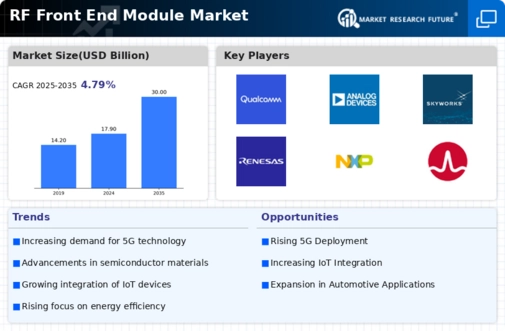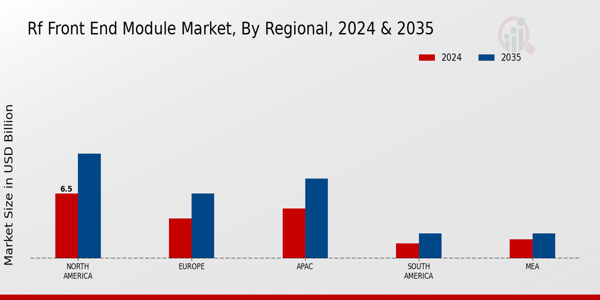Advancements in 5G Technology
The rollout of 5G technology significantly influences the Global RF Front End Module Market Industry. With its promise of higher data rates and lower latency, 5G requires sophisticated RF front end modules to manage the increased frequency bands and complex signal processing. As the global telecommunications infrastructure evolves, investments in 5G networks are expected to drive the market's expansion. The anticipated growth from 17.9 USD Billion in 2024 to 30 USD Billion by 2035 indicates a robust CAGR of 4.79% from 2025 to 2035. This advancement not only enhances mobile broadband services but also supports the development of smart cities and autonomous vehicles, further stimulating demand.
Market Trends and Projections
The Global RF Front End Module Market Industry is characterized by dynamic trends and projections that reflect its evolving landscape. The market is anticipated to grow from 17.9 USD Billion in 2024 to 30 USD Billion by 2035, indicating a compound annual growth rate of 4.79% from 2025 to 2035. This growth trajectory suggests a robust demand for RF front end modules across various applications, including telecommunications, automotive, and consumer electronics. The increasing complexity of communication systems necessitates innovative RF solutions, further driving market expansion. As the industry adapts to emerging technologies, the future appears promising for RF front end modules.
Rising Adoption of Smart Devices
The Global RF Front End Module Market Industry is witnessing a notable increase in the adoption of smart devices, which is a key driver of market growth. As consumers increasingly favor smart home technologies, wearables, and connected appliances, the demand for advanced RF front end modules escalates. These modules are essential for ensuring optimal performance and connectivity in smart devices. The market's projected growth from 17.9 USD Billion in 2024 to 30 USD Billion by 2035 reflects the expanding ecosystem of smart technologies. This trend indicates a shift towards more integrated and intelligent solutions, highlighting the critical role of RF front end modules in enhancing user experiences.
Growth of Internet of Things (IoT)
The Global RF Front End Module Market Industry is significantly impacted by the rapid growth of the Internet of Things (IoT). As more devices become interconnected, the demand for efficient RF front end modules rises to ensure reliable communication. IoT applications span various sectors, including healthcare, agriculture, and smart homes, necessitating robust RF solutions. The increasing number of connected devices is projected to drive market growth, with the industry adapting to meet the specific requirements of IoT applications. This trend underscores the importance of RF front end modules in enabling seamless connectivity and data exchange, thereby enhancing operational efficiency across multiple domains.
Increasing Demand for Wireless Communication
The Global RF Front End Module Market Industry experiences a surge in demand driven by the proliferation of wireless communication technologies. As mobile devices and IoT applications become ubiquitous, the need for efficient RF front end modules intensifies. In 2024, the market is projected to reach 17.9 USD Billion, reflecting the growing reliance on wireless connectivity. This trend is likely to continue as advancements in 5G technology and the expansion of smart devices necessitate enhanced RF performance. The integration of RF front end modules in smartphones, tablets, and wearables illustrates their critical role in facilitating seamless communication, thereby propelling market growth.
Regulatory Support for Wireless Technologies
The Global RF Front End Module Market Industry benefits from regulatory support aimed at promoting wireless technologies. Governments worldwide are implementing policies that encourage the development and deployment of advanced communication systems. This regulatory environment fosters innovation and investment in RF technologies, facilitating the growth of the market. As countries strive to enhance their telecommunications infrastructure, the demand for RF front end modules is expected to rise. This support not only aids in the expansion of existing networks but also paves the way for future advancements in wireless communication, thereby contributing to the overall growth of the industry.





















